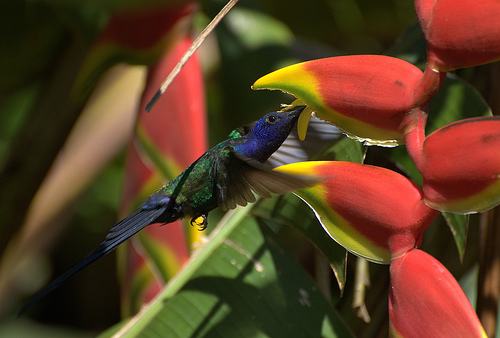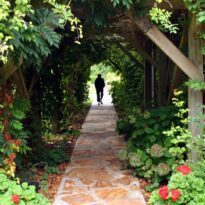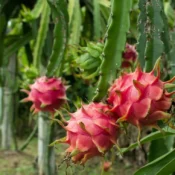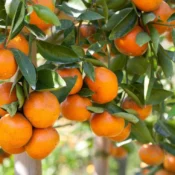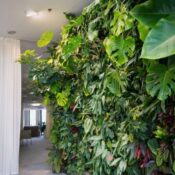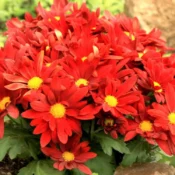
Who doesn’t enjoy the visit of these small wonders of nature, whether the lively and graceful hummingbirds or the beautiful and colorful butterflies, these visitors seem to complete the landscape. It’s nature adding its final touch to the garden that we have carefully planned and implemented. But it is possible to give nature a little push: With the right species of plants, which attract them especially, we can enjoy their presence even more without the need for artificial feeders, which, if poorly managed, can cause diseases in the little creatures.

Check out the list of species below, all flowering and super attractive to butterflies and hummingbirds, who come to delight in their juicy and abundant nectar. Choose your favorites and plant them in areas suitable for observation in the garden, such as within the field of view of the window, the entrance of the house, or the balcony.
- Lantana – Lantana camara
- Heliconias (Parakeet Flower)
- Verbena – Verbena hybrida
- Perennial Petunia – Petunia integrifolia
- Cosmos – Cosmos bipinnatus
- Lavender – Lavandula sp
- Coral Plant – Russelia equisetiformis
- Phlox – Phlox drummondii
- Torch Lily – Kniphofia uvaria
- Lupine – Lupinus hybridus
- Scarlet Sage – Salvia splendens
- Chinese Hibiscus – Hibiscus rosa-sinensis
- Turk’s Cap – Malvaviscus arboreus
- Egyptian Star Cluster – Pentas lanceolata
- Zinnia – Zinnia elegans
- Bougainvillea – Bougainvillea glabra
- Cockspur Coral Tree – Erythrina crista-galli
- Bird of Paradise – Strelitzia reginae
- Busy Lizzie – Impatiens walleriana
- Daylily – Hemerocallis x hybrida
- Cypress Vine – Ipomoea quamoclit
- Powder Puff – Calliandra tweedii
- Chinese Trumpet Vine – Campsis grandiflora
- Brazilian Plume Flower – Justicia carnea
Shall we get to know these plants up close?
1. Lantana – Lantana camara

Lantana (Lantana camara) is a resilient, colorful, and highly adaptable species. Its colorful and fragrant flowers attract a wide variety of pollinators, including butterflies and hummingbirds. This plant is valued in gardens both for its beauty and its ability to attract wildlife.
The cultivation of Lantana is simple, preferring locations with full sun and well-drained soil. Additionally, it is drought-resistant and suitable for coastal areas, making it an excellent choice for low-maintenance gardens.
2. Parakeet Flower – Heliconia psittacorum
![]()
The Parakeet Flower (Heliconia psittacorum) is a typically tropical plant that stands out for its bright and colorful bracts. These showy bracts are actually the plant’s inflorescences, which house small nectar-rich flowers, irresistible to hummingbirds.
The Parakeet Flower prefers warm and humid environments, with plenty of indirect light or partial shade. Its cultivation in cooler regions can be done in protected locations, with enough humidity and warmth, as it is not frost-resistant.
3. Verbena – Verbena hybrida

Verbena (Verbena hybrida) is a perennial plant that features flowers in a variety of vibrant colors, such as red, purple, pink, white, and blue. Its flowers form umbrella-shaped clusters at the top of the branches and are particularly appreciated by butterflies and other pollinators.
Verbena is easy to grow and thrives in full sun, with well-drained soil. It is a great option for flower beds, borders, and as a plant for pots and planters, due to its long flowering period.
4. Perennial Petunia – Petunia integrifolia

Unlike common hybrid petunias, the Perennial Petunia (Petunia integrifolia) is a species with smaller flowers, but it compensates in vigor and durability. Adaptable to a wide range of conditions, this petunia blooms abundantly from spring to fall, attracting butterflies and hummingbirds with its tubular nectar-rich flowers.
It prefers full sun to partial shade and well-drained soil, making it an ideal choice for flower beds, or hanging baskets.
5. Cosmos – Cosmos bipinnatus

The Cosmos (Cosmos bipinnatus) is known for its delicate and airy flowers that dance in the wind on thin and long stems. The colors of the flowers range from white to pink, red, and shades of orange, creating a stunning visual effect when planted in mass.
This plant is extremely easy to grow from seeds and can self-sow, providing a continuous parade of flowers from summer to early fall, and resprouting the following year. The Cosmos is particularly attractive to butterflies, which are enticed by its vibrant flowers and accessible nectar.
6. Lavender – Lavandula sp

Lavender, with its characteristic fragrance and flowers in shades of lilac and purple, is a classic in any garden seeking to attract butterflies and other pollinators. The species Lavandula sp is known for its calming properties and is widely used in the cosmetics and aromatherapy industry.
It prefers well-drained soils and plenty of sunlight, making it ideal for rock gardens, borders, and as an ornamental plant in pots. Its drought resistance makes it a popular choice for low-maintenance gardens.
7. Coral Plant – Russelia equisetiformis

Russelia equisetiformis, known as coral plant, is a feast for pollinators, with its profusion of red, hanging flowers. It is an easy-to-grow plant that stands out in tropical and subtropical gardens.
This perennial shrub is especially appreciated by hummingbirds, thanks to the shape of its flowers, which are tubular and perfectly adapted for feeding these birds. The coral plant is ideal for use in raised beds, hanging baskets, and as a vegetative curtain due to its rapid growth and hanging aspect.
8. Phlox – Phlox drummondii

Phlox, or Phlox drummondii, is an annual plant that delights with its colorful and vibrant flowers, which can vary from white to pink, purple, and red. This species is particularly attractive to butterflies and other pollinators, thanks to its nectar-rich flowers. It is an excellent choice for flowerbeds, borders, and adding color to rock gardens.
Phlox prefers fertile, well-drained soils and locations with good sun exposure, although it tolerates partial shade. Its cultivation is relatively simple, and its prolonged blooming, from spring to fall, ensures a lasting spectacle of colors in the garden.
9. Torch Lily – Kniphofia uvaria

The torch lily or red hot poker, Kniphofia uvaria, is a perennial plant that stands out for its unique torch-shaped inflorescences, with colors ranging from yellow to intense red. This species is highly appreciated in landscaping projects for its striking visual effect and for attracting a variety of pollinators, including hummingbirds.
It adapts to a variety of soils but prefers those that are rich and well-drained, with full sun exposure.
10. Lupine – Lupinus hybridus

Lupinus hybridus, commonly known as lupine, stands out for its long floral spikes, which appear in a variety of vibrant colors and gradients, such as blue, pink, purple, and white. This plant is highly appreciated by both hummingbirds and butterflies, due to the abundance of nectar in its flowers.
In addition to its ornamental value, lupine is known for its ability to fix nitrogen in the soil, improving its fertility. It prefers slightly acidic, well-drained soils and locations with full sun or partial shade. Lupines are excellent choices for mixed beds, cottage gardens, and as focal plants in landscape compositions.
11. Scarlet Sage – Salvia splendens

Salvia splendens, popularly known as scarlet sage, is a species that truly lives up to its name, bringing vibrancy and color to green spaces. Native to Brazil, this perennial plant is widely cultivated in temperate to tropical climate regions due to its long and vibrant blooming.
The flowers, which can vary in shades of red, white, pink, and orange, emerge on erect spikes that attract hummingbirds and butterflies. It enjoys full sun and fertile, well-drained soils.
12. Chinese Hibiscus – Hibiscus rosa-sinensis

The Hibiscus rosa-sinensis, simply known as hibiscus, is one of the most appreciated ornamental plants in tropical and subtropical gardens around the world. With its origins in Asia, this shrubby and perennial species is celebrated for its large and showy flowers, which can be found in a wide range of colors, including red, pink, orange, yellow, and white.
The hibiscus requires full sun, rich and well-drained soil, and is relatively easy to grow, making it a popular choice for gardeners wishing to add a tropical touch to their surroundings.
13. Turk’s Cap – Malvaviscus arboreus

The Malvaviscus arboreus, known as Turk’s cap or Wax Mallow, is a perennial shrub that belongs to the Malvaceae family, the same as hibiscus. Native to the Americas, from the southern United States to Brazil, this species is admired for its red or pink flowers. The flowers of Turk’s cap, which remain partially closed, attract a variety of pollinators, especially hummingbirds, due to their rich source of nectar.
This shrub, which can reach heights of up to 2 meters, is ideal for use as a living fence or as part of landscape compositions in shaded or semi-shaded areas, providing a lush and tropical visual.
14. Egyptian Star Cluster – Pentas lanceolata

The Pentas lanceolata, known as Egyptian star, is a perennial tropical plant that stands out for its star-shaped inflorescences, which can adorn the garden with vibrant colors such as pink, red, white, and lilac. Native to Africa, this species is highly attractive to butterflies and hummingbirds, thanks to its abundant nectar.
The Egyptian star thrives under full sun or partial shade, in well-drained soils, making it a valuable addition to flower beds, borders, or even as a potted plant. Besides its ornamental beauty, the Egyptian star is easy to care for.
15. Zinnia – Zinnia elegans

Zinnia elegans, popularly known as zinnia, is one of the most colorful and easy-to-grow flowers, making it extremely popular. Native to Mexico, this annual plant stands out for its wide range of vibrant colors and flower shapes, ranging from simple petals to more complex forms like pompons.
Zinnias bloom abundantly from mid-summer to fall, offering a lasting visual spectacle and attracting butterflies. They look beautiful in beds and borders, and their cultivation is simple, requiring only a location with full sun and well-drained soil, being also known for their resistance to diseases and pests when well cared for.
16. Bougainvillea – Bougainvillea glabra

The Bougainvillea glabra, known as bougainvillea, is a perennial climbing plant famous for its colorful bracts, which are often mistaken for flowers. Native to South America, this species can transform any landscape with its cascades of intense colors, such as pink, red, orange, purple, and white.
Bougainvillea is ideal for covering pergolas, walls, and fences, creating a spectacular visual effect. Besides its ornamental value, this plant is resilient and prefers locations with full sun for better development and blooming. Bougainvillea can also be grown in pots, which is a great option for balconies and terraces.
17. Coral Tree – Erythrina crista-galli

The Erythrina crista-galli, known as coral tree, is an ornamental tree native to South America, particularly from the regions of Brazil, Argentina, and Uruguay. It is characterized by its stunning tubular red flowers, which mainly appear during the summer months, offering a spectacular visual show.
The coral tree is often used in landscaping, especially in poorly drained areas, due to its beauty and ability to attract wildlife, such as hummingbirds, thanks to its nectar.
18. Bird of Paradise – Strelitzia reginae

The Strelitzia reginae, known as bird of paradise, is a perennial plant native to South Africa, famous for its spectacular flowers that resemble an exotic bird. The vibrant colors of these flowers, combining orange with blue or white, make them a highlight in any garden or floral arrangement.
The bird of paradise mainly blooms in the warmer months, requiring direct sunlight or partial shade and well-drained soil for optimal growth. Besides its stunning beauty, the bird of paradise is relatively easy to care for, resistant to most pests and diseases.
19. Busy Lizzie – Impatiens walleriana

The Impatiens walleriana, popularly known as Busy Lizzie, is an annual herbaceous plant that stands out for its colorful and bright flowers, which can vary from white to pink, red, and violet. Native to East Africa, the Busy Lizzie is highly appreciated in gardens around the world for its continuous and abundant blooming, lasting from spring until the first sign of frost.
This plant prefers locations with partial shade, protected from direct midday sun, except for the cultivar Sunpatiens, and well-drained soil, kept consistently moist. Busy Lizzie is ideal for flower beds, borders, pots, and planters, where its cheerful and vibrant flowers can truly shine.
20. Daylily – Hemerocallis x hybrida

Hemerocallis x hybrida, known as daylily or lily-of-a-day, is a perennial plant that earned its name due to the short lifespan of its flowers, which typically last only a day. However, the plant compensates for this ephemerality by producing a large number of flowers in spring and summer. Originating from Asia, daylilies display a wide variety of colors, including yellow, orange, red, pink, and purple, adding a continuous parade of color to the garden from early summer to autumn.
These plants are highly valued for their resilience and adaptability, growing well in a wide range of light conditions, from full sun to partial shade. They prefer rich, well-drained soils.
21. Cypress Vine – Ipomoea quamoclit

Ipomoea quamoclit, commonly known as cypress vine, is a delicate and ornamental annual climber, valued for its star-shaped red flowers and finely cut foliage, which resembles the shape of a skeleton, hence the common name. Originating from the tropical regions of America, this plant is ideal for covering trellises, fences, and delicate arches with much charm.
The cypress vine blooms profusely from summer to early autumn, attracting pollinators like hummingbirds and butterflies to the garden. For optimal growth, it prefers locations with full sun and well-drained soil. Despite its fragile appearance, the cypress vine is quite vigorous and self-sows, potentially spreading quickly.
22. Powder Puff – Calliandra tweedii

Calliandra tweedii, known as powder puff or fairy duster, is a perennial shrub notable for its spectacular flowers, which resemble fluffy and colorful pom-poms. Originating from South America, this plant is highly ornamental, with flowers ranging from pink to red, attracting an abundance of pollinators.
The powder puff adapts well to a variety of climate conditions, preferring full sun or partial shade and well-drained soil. It is ideal for use in gardens as a standalone plant, in groups forming clumps, or as part of flowering hedges, offering an interesting contrast with other foliage and flowers.
23. Chinese Trumpet Vine – Campsis grandiflora

Campsis grandiflora, also known as Chinese trumpet vine, is a vigorous climber that draws attention with its large trumpet-shaped flowers, usually orange to red, that bloom during summer and autumn. Originating from East Asia, this plant is capable of reaching considerable heights, making it perfect for covering walls, fences, and arches, providing a lush, tropical look.
The flowers not only add a burst of color to the garden but also attract hummingbirds, contributing to the biodiversity of the environment. The Chinese trumpet vine prefers sunny locations and well-drained soils, being relatively hardy once established.
24. Brazilian Plume – Justicia carnea

Justicia carnea, commonly known as Brazilian Plume, is a perennial shrub that stands out for its spikes of pink to red flowers, blooming mainly during summer and autumn. Native to the tropical forests of South America, Brazilian Plume is ideal for use in semi-shade areas in the garden, where its vibrant colors can become a true focal point.
The tubular flowers are particularly attractive to hummingbirds, making the plant an excellent choice for gardens aimed at attracting pollinators. Brazilian Plume is relatively easy to grow, preferring moist but well-drained soils and protection from intense cold. Its dense foliage and upright growth habit also make it suitable for use as a background plant in mixed beds, offering a charming contrast with other plants.
As we explore the diversity and beauty of 24 plants to attract butterflies and hummingbirds, we delve into a world of colors, shapes, and textures that enrich our gardens. Each plant not only beautifies our surroundings with its presence but also plays a crucial role in maintaining biodiversity, acting as a living invitation to beautiful butterflies and hummingbirds.
As we plant these species in our gardens, we create oases of life that not only bring joy and dynamism to the garden but also contribute to the health of our planet. For those who wish to take a step further and dive even deeper into the enchanting world of butterflies, I invite you to explore Step-by-Step Guide to Creating a Butterfly Haven. This guide is a window to creating dedicated spaces that not only attract but also nourish and protect these delicate and wonderful creatures.

